
Welcome to the kickoff of our new blog series dedicated to demystifying common misconceptions surrounding Language Models (LLMs) and generative Artificial Intelligence (AI). In this series, we aim to explore prevalent myths, clarify misunderstandings, and shed light on the nuanced realities of working with these cutting-edge technologies.
In recent years, LLMs like GPT-3, Gemini, LLama 3 have garnered significant attention for their impressive capabilities in natural language processing. However, with this growing interest comes a wave of misconceptions about what LLMs can and cannot do, often overlooking the vital role of traditional machine learning techniques in AI development.
Myth 1: LLMs Can Do Everything – We do not need Machine Learning.
In the rapidly evolving landscape of artificial intelligence (AI), there’s a prevalent myth that Large Language Models (LLMs) can autonomously handle all tasks, rendering traditional machine learning irrelevant. This oversimplified view is akin to saying, “If I have a hammer, everything must be a nail.” Let’s delve deeper into why this myth needs debunking.
Understanding Large Language Models (LLMs)
LLMs are indeed remarkable at tasks such as understanding text, generating responses, and creating embeddings. They excel in natural language processing, enabling sophisticated interactions with human-like understanding. However, their strength lies primarily in processing textual data.
Limitations with Numerical Data and Complexity
Imagine developing an AI tool for financial analysis that needs to process both textual news articles and numerical data like stock prices and market trends.
While language models excel at understanding and generating text, they struggle with interpreting numerical information. LLMs lack inherent numerical processing abilities, making it challenging to derive insights from complex financial datasets.
In contrast, traditional machine learning techniques are adept at handling numerical data. Methods like regression analysis and time series forecasting enable deeper quantitative analysis and predictive modeling.
To build effective financial analysis tools, developers often combine LLMs for text understanding with machine learning for numerical analysis. This integration maximizes the strengths of both technologies, ensuring comprehensive data processing and informed decision-making.
The Python and API Appeal
You might have heard that with Python and APIs, anyone can start using Large Language Models. It’s true! This makes AI more accessible than ever. You can make cool chatbots or text generators with just a few lines of code.
But here’s the thing. If you want to build something more than a basic chatbot or text generator, you’ll need deeper knowledge. Imagine trying to customize an AI assistant to give legal advice or predict stock prices—that’s where machine learning expertise becomes crucial.
What Machine Learning Adds
Machine learning is like teaching AI to learn from data. With machine learning, you can fine-tune LLMs for specific tasks or combine them with other AI techniques to solve complex problems. This requires understanding algorithms and training models, which go beyond simple API interactions.
Real-World Applications
In industries like healthcare or finance, AI isn’t just about chatting with bots—it’s about making life-saving diagnoses or predicting market trends. This level of customization and precision relies on a blend of language models and traditional machine learning.
Why Backend Knowledge Matters
Without understanding machine learning basics, you’re limited to what pre-built tools can offer. To create truly impactful AI applications tailored to specific needs, you need to dig into the backend—understand how models work and how to optimize them for real-world challenges.
Let’s Embrace Collaboration
In summary, while Python and APIs are a great starting point, fully unleashing the power of AI requires a deeper understanding of machine learning. This knowledge empowers us to create innovative solutions that go beyond simple text interactions, driving progress in diverse industries.
Let’s celebrate the synergy between language models and traditional machine learning, paving the way for AI applications that truly make a difference.